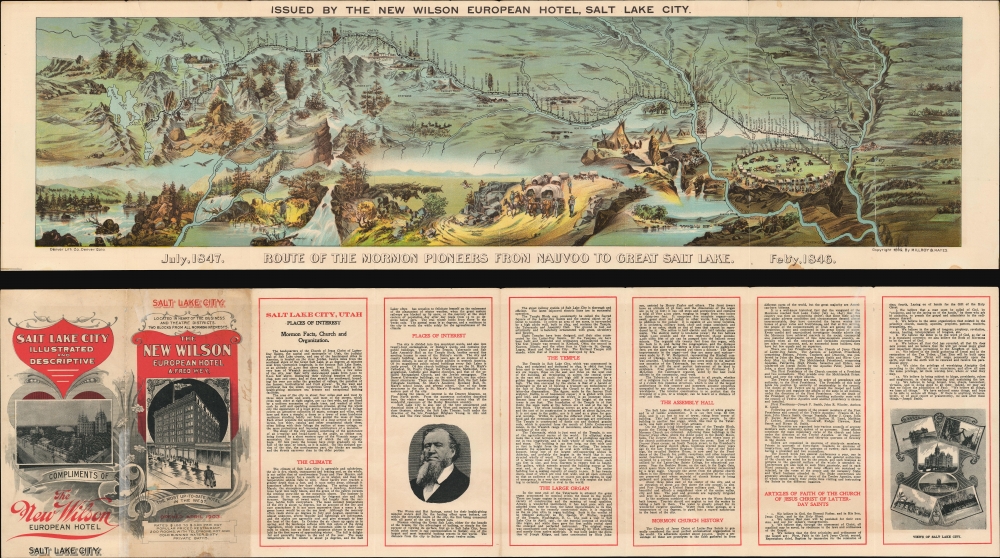1899 Panoramic View Map 'Route of the Mormon Pioneers' (Nebraska, Utah, Wyoming)
MormonPioneers-millroyhayes-1899-4
Title
1899 (dated) 8.5 x 29 in (21.59 x 73.66 cm) 1 : 3823000
Description
A Closer Look
This view, by Millroy and Hayes, covers from the Mississippi River to Great Salt Lake, detailing, day-by-day, the 1846 - 1847 westward migration of the Mormon Pioneers from Nauvoo, Illinois to Great Salt Lake, Utah. Vignettes of wagon trains illustrate the route: circled wagons at night, American Indian tepees, the Mormon Battalion, and other dramatic scenery. The map and events are derived from the journals of Orson and Parley P. Pratt, original members of the 'Quorum of Twelve Apostles'.Before the Mormon Trail
From 1838 to 1846, most Mormons settled in Nauvoo, Illinois under the leadership of Brigham Young. Tensions between the newly arrived Mormons and established Nauvoo residents led to the eviction of the Mormons in 1845. The Quincy Convention demanded that all Mormons withdraw from Nauvoo by 1846. Consulting trappers and frontiersmen, Brigham Young settled on Great Salt Lake, then part of Mexico, as their final destination.The Trek West - The Mormon Trail
The Mormon Trail extends from Nauvoo, Illinois, which was the principal settlement of the Latter Day Saints from 1839 to 1846, to Salt Lake City, Utah, settled by Brigham Young and his followers from 1847. The trek westward began on February 4, 1846. After crossing the Mississippi River at Nauvoo, the pioneers passed through the Iowa Territory following early explorer's routes and Native American paths. Rain, mud, swollen rivers, and poor preparation slowed the voyage, turning the rolling plains of southern Iowa into a quagmire of axle-deep mud. Furthermore, few people carried adequate provisions. The weather, general unpreparedness, and lack of experience in moving such a large group contributed to the extreme hardship for which the migration is known. The Latter-Day Saints wintered on the Missouri River at a camp called 'Winter Quarters' before pressing on to Fort Laramie. From Laramie, the pioneers began the arduous ascent to South Pass, crossing the Rocky Mountains and descending into the Great Basin. They arrived at Great Salt Lake in July 1847. One year later, in 1848, at the end of the Mexican-American War (1846 - 1848), the Great Basin and the rest of the American West were ceded to the United States in the Treaty of Guadeloupe-Hidalgo.Chromolithography
Chromolithography, sometimes called oleography, is a color lithographic technique developed in the mid-19th century. The process involved using multiple lithographic stones, one for each color, to yield a rich composite effect. Typically, the process would start with a black basecoat upon which subsequent colors were layered. Some chromolithographs used 30 or more separate lithographic stones to achieve the desired product. Chromolithograph color could also be effectively blended for even more dramatic results. The process became extremely popular in the late 19th and early 20th centuries when it emerged as the dominant method of color printing. The vivid color chromolithography produced made it exceptionally effective for advertising and propaganda imagery.Publication History and Census
There are two known editions of this view map, small and large, both of which have become extremely rare. The present example, published by Millroy and Hayes in 1899, corresponds to the smaller edition. The smaller edition is about 1/3 the size of the large format edition and was prepared by the New Wilson European Hotel and issued later in 1899. This piece is well cataloged in OCLC, although, due to cataloging inconsistencies, it is very difficult to know which edition each institution possesses in its collection.CartographerS
Millroy and Hayes (fl. c. 1899) were Salt Lake City based printers active in the late 19th century. They are best known for their panoramic birds-eye view illustrating the route of the Mormon Pioneers. No other publications by this firm have been recorded. More by this mapmaker...
Denver Lithographing Company (fl. c. 1875 - 1925) was a late 19th and early 20th century printing and lithography firm active in Denver, Colorado. It was first named Charles S. Stone and Company, after its founder, but by 1876 was operating as the Denver Lithographing Company out of 389 Larmier Street. Co-owners included Richard P. Goddard and Edwin Wagner. The firm was an early adopter of chromolithography and uniquely produced some of the most dramatic early advertising images of the American west. We have been unable to discover more regarding the founders. Learn More...

